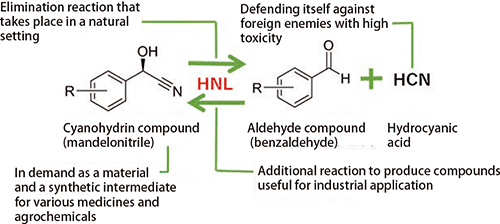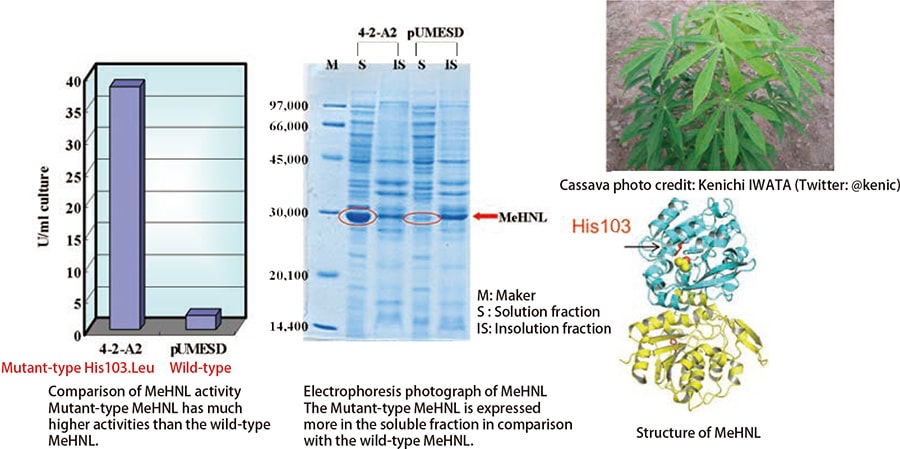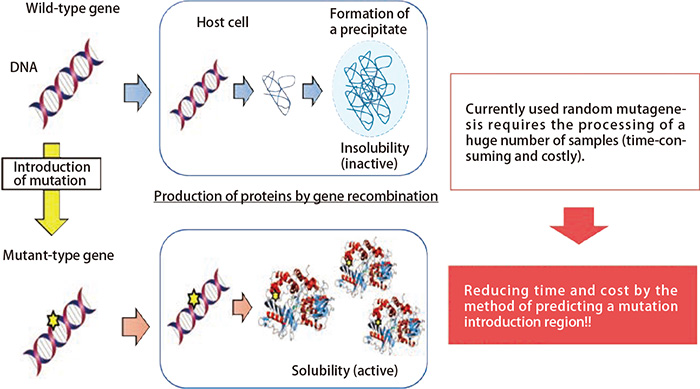Research Results
Toward the establishment of Eco-friendly industrial technologies
Interdisciplinary research expands enzyme application FY2017

- Yasuhisa Asano (Professor, Department of Biotechnology and Biotechnology Research Center, Toyama Prefectural University)
- ERATO
- "ASANO Active Enzyme Molecule Project" Research Director (2011-2017)
Enzymes that support our lives
When you search the word "enzyme" on the Internet, you will find a lot of information. Although enzymes are used in various things around us, such as detergents and supplements, little is known about them. If you have learned a little bit about biology or chemistry, you may know that "enzymes are proteins, consisting of many amino acids," "enzymes catalyze the chemical reaction to convert one substance to another at ordinary temperatures and pressures" and "many kinds of enzymes are found in living organisms." Enzyme-catalyzed chemical reactions are generally more efficient and emit less toxic substances compared to metal-catalyzed reactions. In addition, enzyme-catalyzed chemi- cal reactions can be caused under mild conditions with temperature and pH level like those in our body. For this reason, material production using enzymes has attracted attention as an Eco-friendly technology, and much effort is being put into itspractical use in the field of chemical industry. In order to further expand the application of enzymes in this field, developing stable and highly active enzymes is required.
Professor Yasuhisa Asano, Research Director of "Exploratory Research for Advanced Technology" (ERATO) , JST, has worked on a project to establish technologies to produce a useful material using various enzymes with the aim of paving the way for the advancement of material production that reduces the effects on the environment. In this project, he has taken interdisciplinary approaches toward the discovery of new useful enzymes and the establishment of technologies to utilize them.
Discovering high-performance enzymes from an animal that used to attract little attention
One of the features of Professor Asano' s study lies in its comprehensive approach; he has focused not only on microorganisms and plants that have been covered in many studies, but also on animals that have attracted very little attention as resources for industrial enzymes due to their difficulty in handling. In recent years, when searching for new enzymes, many researchers narrows down the possibilities beforehand by using genome sequences of already-known enzymes. That is because if researchers have to discover new enzymes in animals or plants without using genome sequences, they need to prepare liquid extracts from a large amount of samples, and then examine the enzymatic activity of every single extracts, which requires painstaking work. However, Professor Asano thought that there are limitations to the search method relies only on genome sequences, and it is necessary to use a fundamental search method to discover new enzymes.
Professor Asano has been conducting research on enzymes that produce nitrogen-containing compounds for many years. In particular, Professor Asano is familiar with the enzyme " hydroxynitrile lyase (HNL)," which is used for the production of a cyanohydrin compound, a synthetic material for medicines and agricultural chemicals. Like an almond-derived HNL, which has found its application in industries, HNLs have been isolated from plants, and most of them were discovered in the laboratory of Professor Asano. On the other hand, the existence of animal-derived HNLs had remained unknown. Professor Asano thought that there must be unexplored enzymes lying in animals, and he started searching for animal-derived HNLs. In an industrial application, HNLs have been used to synthesize a cyanohydrin compound from hydrocyanic acid and aldehyde. However, HNLs also catalyze the reaction of decomposing a cyanohydrin compound into hydrocyanic acid and aldehyde, which plants and animals use as protection measures against enemies (Fig. 1). With that in mind, Professor Asano set his eyes on an arthropod, in particular, a millipede (Fig. 2). He thought that millipedes that spray hydrocyanic acid to threaten enemies would possibly have HNL.
However, in order to find out if millipedes have HNL, it was necessary to isolate an enzyme that produces hydrocyanic acid from millipedes, and to that end, a huge number of millipedes had to be collected. He had read an article about an outbreak of millipedes in a book before. According to the article, a massive outbreak intense enough to cause cancellation of train operation takes place every 10 years or more in limited areas, so he had been hoping to encounter such an opportunity. And one day, Professor Asano received news of a massive outbreak of millipedes. He contacted with the local government for permission to collect millipedes, and he could get a large number of them in the area. Although it took a lot of time and effort to grind a large number of millipedes and to purify the enzyme from them, he had succeeded in identifying the HNL genes of a millipede by examining the amino acid sequence of the enzyme he obtained. As a result of thorough examination of the millipede-derived HNL, this HNL was found to have very high enzyme activity that was 5 to 300 times higher than that of known enzymes and high stability; therefore, the millipede-derived HNL is expected to be used for industrial purposes in the fields of chemical engineering as a replacement for the currently used plant-derived enzymes.
Moreover, it was revealed that this millipede-derived HNL has an amino acid sequence that is considerably different from conventionally known HNLs; therefore, it was considered that the unique genetic origin of the millipede-derived HNL that is different from those of HNLs of other living organisms is responsible for its high enzyme activity. This is a valuable example showing the possibility that enzymes that will be able to be used widely and effectively are also present in animals that have not yet attracted attention. This research result indicates that various animals can be viewed as subjects of research on gene resources of industrial enzymes, and that those enzymes may not be found only from known gene sequences.
Fig. 1 Hydroxynitrile lyase

Fig. 2 Chamberlinius hualienensis

Solving a bottleneck in enzyme application
For practical use of discovered useful enzymes, it is necessary to synthesize enzymes and mass-produce them. Among several methods for the synthesis, Professor Asano used a gene recombination expression system. In this method, genes of the target enzymes are introduced into a host cell such as Escherichia coli and yeast in order to conduct large-scale synthesis. However, proteins synthesized by means of genomic recombination were very likely to become insoluble precipitates which causes a bottleneck since that did not have enzyme activity. To realize industrial application of proteins, it is necessary to express proteins in a soluble state. As methods for soluble expression, modification of hosts, examination of culturing conditions of hosts, a method of searching for mutants that cause soluble expression by randomly introducing mutation into genes (random mutagenesis), fusion with another soluble protein, etc. are employed. However, those methods, in addition to being costly, require trial and error as well as time, which poses a problem. With that, Professor Asano collected many cases in which insolubility changed to solubility by genetic mutation (Fig. 3), and by analyzing those cases, he found a law regarding a change in enzymes from insolubility to solubility. Based on this information, he developed a method of predicting which amino acid in a protein and how that amino acid should be substituted in order to solubilize an enzyme without changing the enzyme' s original properties (Fig. 4). Since this method allows examination of conditions for solubilization to be conducted on a computer program, it is an epoch-making method that saves time and cost. Additionally, he has succeeded in the solubilization of about half of the tested proteins; thus, he is aiming to further improve the success rate of solubilization. Also, he has already applied for a patent of the method, so its development is expected in the future.
Fig. 3 Soluble expression in Escherichia coli by introducing mutation into a plant (cassava)-derived HNL (MeHNL)

The above shows an example in which soluble expression was successfully performed with a gene recombination expression system by introducing mutation into a cassava-derived HNL. By accumulating a lot of mutation information leading to the acquisition of solubility and discovering regularity therebetween, it became possible to predict mutation sites for soluble expression.
Fig. 4 Development of soluble expression technology by the prediction of a mutation region

By predicting a mutation introduction region leading to soluble expression, it will become possible to solve the problems associated with prediction and cost posed by the conventional random mutagenesis.
Toward the new development of enzyme application
Thus, Professor Asano' s research on millipedes has attracted attention, and he often says with a forced smile: "Recently, people call me Professor Millipede." However, what Professor Asano is aiming at is the new development of enzyme application including material production.
Enzymes can be used in various fields, in addition to material production such as the production of antibiotics, medicine, foods, etc. For example, enzymes can also be used when inspecting abnormalities of the human body such as disease. When a person gets sick, the concentration of a specific amino acid in the body greatly changes due to the disease. That is, if it becomes possible to quantify the amount of amino acids in the blood and urine in a simple way with high accuracy, medical checkups can be performed accurately and simply. Although most of the currently used apparatus and reagents have the problem of requiring high cost, this issue will possibly be solved if enzymes become available.
There are a variety of creatures in nature, and it is important to further understand their characteristics and to search for useful enzymes from them. By combining these knowledge with a new protein modification technology developed using information science and bioengineering, the door to the wider development of enzyme application will open to create eco-friendly society in the future.
